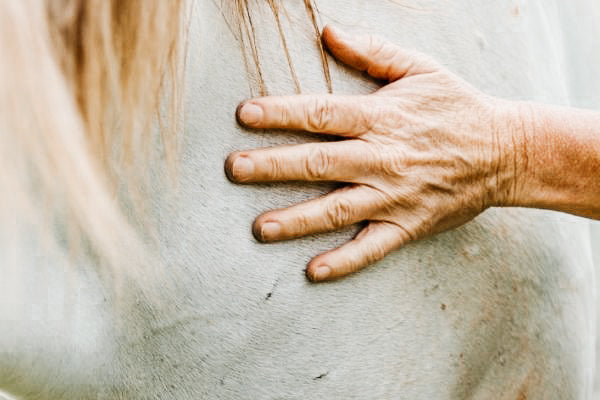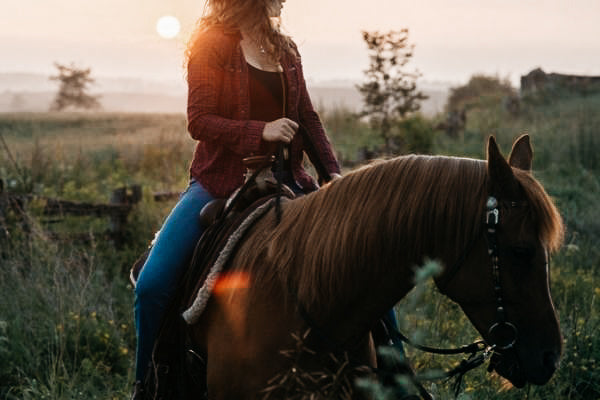
Safe off-road – the way out
A relaxed ride into the great outdoors is every riding student's dream. But cross-country riding is also a top priority for horse owners. Recreational riding is booming and equestrian sports are increasingly being moved outside. As a stressed-out office worker, variety, joy and relaxation are just what you need.
But we shouldn't forget: every off-road excursion brings new challenges for horse and rider. This not only guarantees a period of relaxation and fun, but also excitement. Thorough training for both(!) is important in order to avoid a riding accident. You have to grow together as a team!
Requirements of rider and horse
Since there are significantly more difficulties to overcome when riding than in a separate riding arena, solid basic training must be provided beforehand. Ask yourself: Am I fit? Can I keep my horse under control in all three basic gaits? Does it trust me? Do I know the psyche and instincts (e.g. b innate flight behavior) from him? Does my horse react reliably to my help?
Because: You are dealing with an independent being! Unpredictable reactions from the animal must always be expected. Your horse is not sports equipment! The better you know your partner, the less you will be surprised by their actions. Riding horses requires more than riding breeches and a helmet. Especially when riding. Otherwise you will endanger yourself and others.
Primal instincts play a big role
Whether flight behavior or herd instinct - the natural instincts of these noble creatures extend into domestication. It is simply innate that your friend suspects there is a predator behind a rustling bush. Does your horse perhaps not feel like leaving the stable? This is also a primal instinct. The herd gives him protection. It has learned this over thousands of years of evolution. Therefore we should take it seriously. Punishing such reactions would be a mistake. It is better to build trust and show the horse that he can rely on you.
Quasi: With you there is no danger of any harm coming to him. For example, ground work with a horse is ideal for this. Just riding horses will get you to your destination more slowly. Communication begins on the ground. Your horse reads your body language and learns from you. You, in turn, get to know his moods and behavior. This is a wonderful win-win situation.

Primal instincts play a big role
Whether flight behavior or herd instinct - the natural instincts of these noble creatures extend into domestication. It is simply innate that your friend suspects there is a predator behind a rustling bush. Does your horse perhaps not feel like leaving the stable? This is also a primal instinct. The herd gives him protection. It has learned this over thousands of years of evolution. Therefore we should take it seriously. Punishing such reactions would be a mistake. It is better to build trust and show the horse that he can rely on you.
Quasi: With you there is no danger of any harm coming to him. For example, ground work with a horse is ideal for this. Just riding horses will get you to your destination more slowly. Communication begins on the ground. Your horse reads your body language and learns from you. You, in turn, get to know his moods and behavior. This is a wonderful win-win situation.
Alone or a group ride?
Inexperienced riders should always be accompanied by one or more experienced pairs of riders. It is very important that your horse feels the calm of experienced horses. A skittish horse in particular has the opportunity to relax and gain confidence. If it doesn't have these requirements, in the worst case scenario it could run away and cause a riding accident.
Whether it's trail riding, orienteering or daily cross-country riding - the security of an experienced companion horse is worth its weight in gold! In addition, “in the event of an emergency,” a helper is immediately on hand.
So please always ask horse owners who have a calm animal themselves and take your inexperience seriously. The following applies: the weakest rider sets the pace! With this approach, your friend is well on the way to becoming a reliable horse.
If you go for a ride without someone accompanying you, it would make sense to always leave a message in the stable. In it you note your planned route and the time from the start of the ride to your expected return. In an emergency, they can search for you.
Good equipment is the be-all and end-all
The saddle and bridle must be intact. When trail riding, everything should meet the requirements and be safe. It would be fatal if, for example, a saddle girth broke or the reins vanished into thin air during a group gallop. It is also important that the equipment fits. Horse and rider. A poorly fitting saddle quickly creates chafing and pressure points that are painful for the horse. In the worst case scenario, the animal escapes and runs away.
As a responsible rider, you pay attention to such things. Also note: You should never go without a tested riding helmet and boots with heels!
Correct behavior in the field
It doesn't matter whether you ride in western riding style, as a show jumper or as a dressage rider. Your horse should be able to stand well on the aids and balance itself outside. It therefore makes sense to get used to a loose rein control. This means it has its neck free to act as a balancing pole and can easily overcome rough terrain.
The right-hand riding requirement applies in street areas. Traffic signs and traffic lights also apply to riders. Hand signals are given like when cycling. If you are traveling in the dark, there must be sufficient lighting. Reflective gaiters and vests are recommended. It goes without saying that you behave considerately and kindly towards other road users and pedestrians.
Always pay attention to the weather conditions. Soggy field paths and meadows are slippery and ice can quickly form in winter. Adjust gaits! Riding horses off-road means covering at least 85% of the distance at a walk anyway. In addition, a good, diligent step keeps your horse healthy.
Obstacles
To avoid obstacles such as b To respond positively to bridges, streams and everyday noises, ground work with horses is again an option. You can prepare your darling easily on the riding arena. With a fluttering curtain, a rattle bag, umbrellas and a small bridge made of wooden planks etc. These things can be gently introduced to him. This ground work in particular is well received by the horse and beneficially strengthens your foundation of trust. The next stage towards the leaving horse has now been completed.
The journey is the destination
Riding horses in the field is wonderful, but also involves knowledge and work (in the form of solid training for horse and rider). Once you have laid solid foundations for working together, going into open terrain will be a great, relaxing change for you.
Enjoy!
Discover more posts

Bioresonance therapy is used by us humans to alleviate a variety of complaints. Electromagnetic vibrations are sent via metal electrodes. The method is based on the approach that every cell ge...
Continue reading
Trail riding – holiday enjoyment on horseback
Is there anything nicer than roaming through forests and fields with your four-legged partner, traveling through valleys and exploring new landscapes in the saddle every day? Waking...
Continue reading
